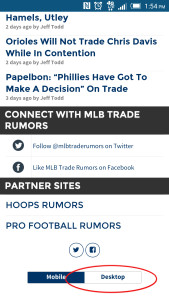There are many ways to break out the bunches of deals we see at the trade deadline every year, and the division of teams into buyers and sellers may no longer mean quite what it did before the addition of a second Wild Card. But it nevertheless remains clear that a good number of teams can be placed into those two camps, at least now that the moves are in the books, and we didn’t really see any club pull off the balleyhooed “buy and sell” (even if some tried).
Let’s focus here on the buy-side. Adding players for the stretch (and a possible post-season run) requires teams to identify needs, evaluate internal options, and value their own future assets in structuring deals. Needless to say, there’s far more to it than just getting the best or best-known player you can.
So, here’s the poll question: looking at the teams that made moves to bolster their current rosters, which one made the best additions, all things considered? I’ll organize the teams into rough groupings for ease of reading:
High-Cost Rentals
Two teams pushed their trade chips squarely toward the present, acquiring multiple players who will all become free agents after the season.
Royals acquire Johnny Cueto, Ben Zobrist — This seemed like the moment to push the chips in for GM Dayton Moore, and he did just that, adding two of the most hotly-pursue players. But those big adds came at the cost of appealing arms like Brandon Finnegan and Sean Manaea.
Mets acquire Yoenis Cespedes, Tyler Clippard, Juan Uribe & Kelly Johnson — After adding some solid pieces in areas of need, GM Sandy Alderson pulled the trigger on a marquee rental in Cespedes. The Mets’ overall mix looks much better right now, but they won’t own the rights to the futures of young pitchers Michael Fulmer and Casey Meisner.
Major Moves – Rent And Buy
Those weren’t the only clubs that paid high prices for rentals, but these teams also picked up significant players who will be controllable after 2015.
Astros acquire Scott Kazmir, Carlos Gomez & Mike Fiers — We’ve seen GM Jeff Luhnow as an accumulator of young talent; now, we got to see him spend it. He opted to add a high-upside rental arm, a year and a half of the excellent Gomez, and a controllable arm in Fiers, dealing from the team’s young depth (including high-rated youngsters like Brett Phillips, Josh Hader, and Jacob Nottingham) to do so.
Cardinals acquire Brandon Moss, Steve Cishek, Jonathan Broxton — While the relievers were available for little more than some salary relief, the reasonably affordable and controllable Moss cost highly-regarded pitching prospect Rob Kaminsky. But nobody knows young arms like St. Louis, and they filled a clear need with the slugger.
Blue Jays acquire Troy Tulowitzki & LaTroy Hawkins, David Price, Ben Revere, Mark Lowe — Toronto added some big names despite facing a large deficit in the AL East, and parted with a long list of pitching prospects to get things done, including highly-regarded young hurlers Daniel Norris and Jeff Hoffman.
Dodgers acquire Mat Latos, Alex Wood, Jim Johnson & Luis Avilan — Los Angeles took on a good bit of salary to add a group of solid arms to the big league roster (while also picking up future years of Wood as well as prospect Jose Peraza), and gave up Hector Olivera in the process.
Multiple Veteran Pieces
These teams bulked up on depth pieces who will fill particular roles on their clubs, generally keeping the acquisition costs down in the process.
Angels acquire David Murphy, David DeJesus, Shane Victorino — Los Angeles added three veteran platoon candidates to address its need for bats. It was an interesting strategy, but certainly added plenty of experience and clubhouse presence at a reasonable price.
Pirates acquire Joakim Soria, J.A. Happ, Aramis Ramirez, Michael Morse, Joe Blanton — Pittsburgh added veteran rental pieces at the spots that were in need of shoring up, and didn’t have to part with its best young talent to do so.
Cubs acquire Dan Haren, Tommy Hunter — Chicago reportedly pursued some more impactful moves, but ultimately settled for veteran depth that did not require the team to part with significant future assets.
Single Shots
Several buyers made targeted buys of specific assets that, they hope, will fill a specific need.
Nationals acquire Jonathan Papelbon — It took some financial juggling and created a bit of controversy due to the presence of Drew Storen, but ultimately the Nats got a quality late-inning arm at the cost of some solid upper-level pitching depth (Nick Pivetta).
Giants acquire Mike Leake — San Francisco parted with righty Keury Mella and third baseman Adam Duvall to bolster its rotation with the reliable righty.
Twins acquire Kevin Jepsen — Despite its strong position in the standings, this was Minnesota’s only move. But giving up youth for veterans may not have made much sense, and the August trade market could present opportunities if the club stays in the hunt.
Orioles acquire Gerardo Parra — To add the solid Parra, who is currently in the midst of a career year, Baltimore gave up a good pitching prospect in Zach Davies.
Padres acquire Marc Rzepczynski — Do we call the Padres buyers? Their only move was to add a veteran middle-reliever, and they held multiple impending free agents, so it’s hard to give any other label.
Looking To The Future?
Rangers acquire Cole Hamels & Jake Diekman, Sam Dyson — It may not quite be fair to consider Texas here, since the main move was heavily driven by future considerations, but the club did have to beat out more obvious contenders to get Hamels. It took quite a haul, with top prospects Jorge Alfaro, Jake Thompson, and Nick Williams among the pieces moved.
—

